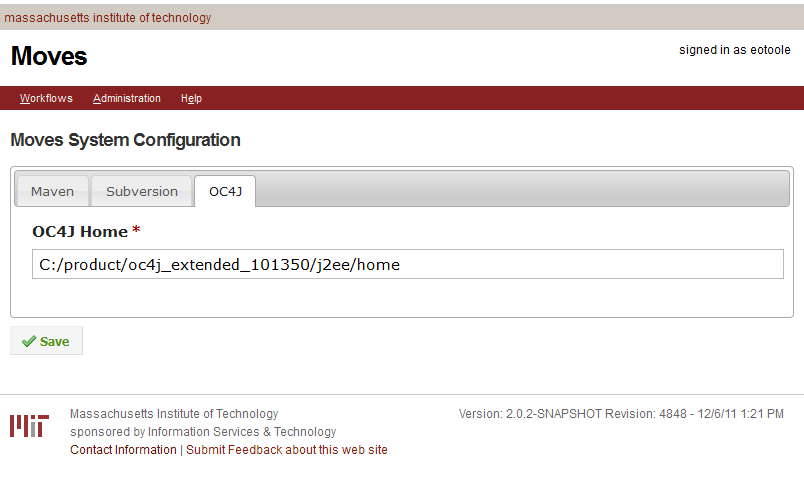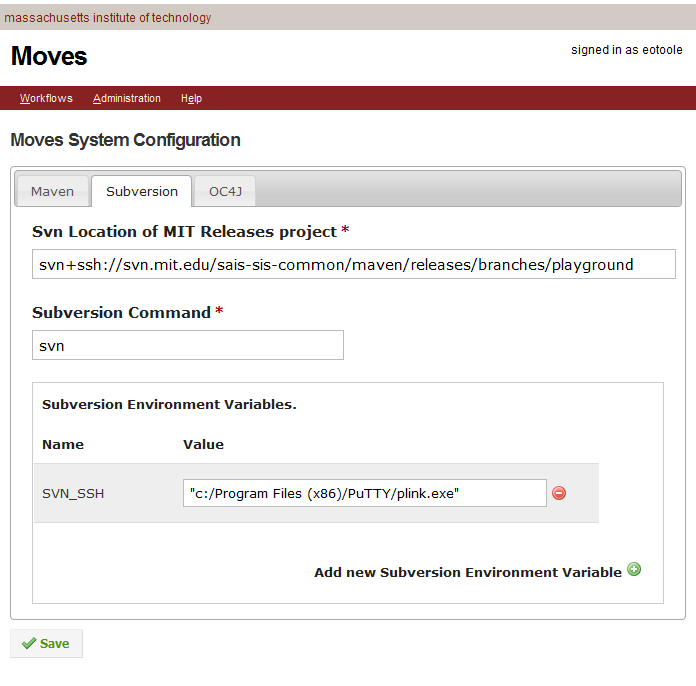| Table of Contents |
|---|
| Note |
|---|
| Wiki Markup |
| {toc}
{note}Moves stores runtime config changes in a file called * Moves stores runtime config changes in a file called $\user.home}/sais-moves-web.properties *. This is to manage properties which change at runtime. Moves also creates a folder called *$\user.home}/sais-moves-web/ *when interacting with subversion and maven. This page assumes that you're starting from scratch, so if these exist, stop OC4J, and rename these to $\user.home}/sais-moves-web.properties.backup and $\user.home}/sais-moves-web.backup respectively. That way you can be sure you are running in the most pristine state possible, and your screens should match those below. {note} It is assumed that you have been able to build and deploy moves, and can access the page [ |
It is assumed that you have been able to build and deploy moves, and can access the page http://localhost:8888/moves/admin/index.htm
...
as
...
outlined
...
in
...
...
...
...
...
...
.
The Build Configuration page
Click on the Build Configuration icon on http://localhost:8888/moves/admin/index.htm
...
.
...
There
...
are
...
3
...
tabs
...
on
...
there....
...
one
...
for
...
Maven
...
configuration,
...
one
...
for
...
Subversion
...
configuration
...
and
...
one
...
for
...
OC4J
...
configuration.
...
Let's
...
start
...
with
...
each
...
tab
...
from
...
simplest
...
to
...
most
...
complex.
...
Build
...
Configuration
...
-
...
OC4J
...
tab
...
The
...
only
...
thing
...
we
...
need
...
to
...
know
...
about
...
oc4j
...
is
...
where
...
the
...
j2ee
...
home
...
folder
...
is.
...
This
...
is
...
so
...
moves
...
can
...
find
...
admin_client.jar,
...
which
...
it
...
uses
...
to
...
deploy
...
applications
...
to
...
containers.
...
Below
...
is
...
a
...
screenshot
...
that
...
I
...
use
...
on
...
windows.
...
Note
...
that
...
I
...
use
...
forward
...
slashes
...
rather
...
than
...
back
...
slashes
...
to
...
separate
...
the
...
path.
...
Back
...
slashes
...
are
...
not
...
supported
...
in
...
the
...
current
...
version
...
of
...
moves.
Click save when you have the oc4j tab configured.
Build Configuration - Subversion tab
Validate Subversion works as expected.
Before we look at Moves, let's first confirm that subversion works on the command line. If it doesn't work, moves certainly won't make it work.
| Panel | ||||
|---|---|---|---|---|
| ||||
|
| Panel | ||||
|---|---|---|---|---|
| ||||
|
| Panel |
|---|
When you've
...
successfully
...
validated
...
subversion,
...
click
...
on
...
the
...
Build
...
Configuration
...
icon,
...
and
...
select
...
the
...
Subversion
...
tab.
...
What
...
we'll
...
need
...
to
...
tell
...
moves
...
is
...
- Where
...
- is
...
- the
...
...
...
...
- How
...
- do
...
- you
...
- want
...
- to
...
- run
...
- Subversion
...
By
...
default,
...
moves
...
will
...
point
...
to
...
the
...
production
...
location
...
of
...
the
...
...
...
...
(svn+ssh://svn.mit.edu/sais-sis-common/maven/releases/trunk).
...
However,
...
Developers
...
who
...
are
...
testing
...
moves
...
will
...
want
...
to
...
point
...
to
...
the
...
Moves
...
Playground
...
Component
...
Registry
...
at
...
svn+ssh://svn.mit.edu/sais-sis-common/maven/releases/branches/playground.
...
So
...
go
...
ahead
...
and
...
change
...
that.
...
If
...
you
...
are
...
running
...
on
...
Unix/Linux,
...
you
...
can
...
remove
...
any
...
Subversion
...
Environment
...
Variables.
...
(REMEMBER
...
to
...
run
...
kinit
...
though,
...
before
...
you
...
start
...
Moves,
...
or
...
moves
...
will
...
hang,
...
waiting
...
on
...
a
...
username/password
...
to
...
be
...
entered).
...
If
...
you
...
are
...
running
...
on
...
Windows,
...
add
...
a
...
Subversion
...
Environment
...
Variable
...
called
...
SVN_SSH
...
with
...
the
...
value
...
which
...
you
...
noted
...
from
...
"Validating
...
Subversion
...
on
...
Windows"
...
above.
...
Below
...
is
...
a
...
screenshot
...
for
...
a
...
typical
...
Windows
...
installation.
| Tip | ||
|---|---|---|
| ||
You an test your subversion setup by clicking on the "Build a release" workflow, and seeing if the drop down is populated with the MIT componenents. If it's not, look carefully at the "Show Log" link that is displayed on that page. |
Build Configuration - Maven tab
This is the most complex of the tabs. What we're doing here is telling moves how to run maven.
- The Maven Command entry should be left as mvn (unless you're doing some really weird shenanigans)
- Check the Run Maven with Debug Output? checkbox if you want REALLY VERBOSE maven log files. Checking this causes mvn to be run with the -e and -X options. It is useful when you're having maven problems, as it will show stack traces and lots of logging. It's annoying when you're not having maven problems, so I suggest leaving it unchecked initially.
- Max Maven Build Time (in seconds) is SUPPOSED to kill a build if it hasn't completed in a certain time. This is not yet implemented... but might be some day.
- MIT Maven Repository (containing releases) should be the location of the MIT Maven release repository. Moves uses this to find released components and display them in the GUI. (Note that this field will hopefully go away in a future release, but for now it's critical, and for now, the default value *https://maven.mit.edu/nexus/content/groups/saisGroupRepo/*
...
- should
...
- be
...
- just
...
- fine).
...
- mit-release-plugin
...
- version.
...
- Moves
...
- uses
...
- the
...
- plugin
...
- edu.mit.maven.plugins:mit-release-plugin.
...
- The
...
- latest
...
- version
...
- can
...
- be
...
- found
...
- by
...
- browsing
...
- the
...
- MIT
...
- Maven
...
- repository.
...
- Maven
...
- System
...
- Properties
...
- can
...
- be
...
- left
...
- blank
...
- for
...
- local
...
- development
...
- environments.
...
- Maven
...
- Environment
...
- Variables
...
- are
...
- needed
...
- because
...
- on
...
- some
...
- OS's
...
- when
...
- you
...
- spawn
...
- a
...
- new
...
- shell,
...
- it
...
- may
...
- or
...
- may
...
- not
...
- inherit
...
- Environment
...
- Variables
...
- from
...
- OC4J's
...
- runtime
...
- environment.
...
- So
...
- what
...
- we
...
- are
...
- doing
...
- here
...
- is
...
- making
...
- sure
...
- the
...
- environment
...
- variables
...
- JAVA_HOME,
...
- SVN_SSH,
...
- M2_HOME,
...
- MAVEN_OPTS,
...
- PATH
...
- and
...
- SVN_SSH
...
- are
...
- set
...
- up
...
- correctly.
...
When
...
Moves
...
shells
...
out
...
to
...
maven,
...
it
...
will
...
add
...
the
...
environment
...
variables
...
shown.
...
(Note
...
that
...
maven
...
itself
...
may
...
fork
...
another
...
process,
...
depending
...
on
...
the
...
goals
...
it
...
is
...
running.
...
but
...
we
...
will
...
discuss
...
that
...
later).
...
It
...
will
...
also
...
add
...
any
...
system
...
properties
...
to
...
the
...
command
...
line
...
with
...
the
...
-D
...
option.
...
Below
...
is
...
a
...
screenshot
...
for
...
a
...
typical
...
Production/Test
...
installation.
And here is a screenshot for a developer installation on Windows



